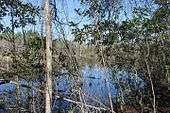Beaver Creek Indian Tribe
 | |
| Total population | |
|---|---|
| (550) | |
| Regions with significant populations | |
|
| |
| Languages | |
| English | |
| Religion | |
| Christianity, Mormonism | |
| Related ethnic groups | |
| Waccamaw, Cheraw, Catawba and other Siouan peoples |
The Beaver Creek Indian Tribe is a small state recognized Native American tribe located in Orangeburg County, South Carolina. They achieved state recognition on January 27, 2006[1] and have begun the process of seeking federal recognition through the United States Bureau of Indian Affairs.[2] They are a member of the South Carolina Indian Affairs Commission.[1]
Their people were recorded on historical lands located between the two forks of the Edisto River, especially along Beaver Creek.[3] Historical accounts document the tribe in this area since the 18th century. Most of the tribe's members still live in the area today. They have traditionally farmed or held other agriculture related jobs. Historically the tribe has been rather isolated with most of its members living predominately rural lives. The tribe has however begun several exposure related initiatives aimed at both preserving their since of Indian identity, while simultaneously educating the general public as to the tribe's existence and culture.
The tribe's historical language family is Eastern Siouan, one of the major languages connecting them to other Piedmont region tribes.[4]
Government

The tribe is governed by a chief, vice chief and nine member tribal council, all of which are elected.[2] Additionally, an elders council provides the tribal council with consultation and advice. Their tribal land is located in Orangeburg County.
History
Dating from the American Revolutionary War through to the late 20th century numerous sources and official government forms documented their people as being 'Indian'.[1] This greatly assisted the tribe in achieving state recognition in the early 21st century. This provided proof that their people had a continuity of cultural and ethnic identity after the American Revolutionary War and throughout the coming years.[2]
In the mid 19th century, their people filed a petition with the state of South Carolina on the behalf of Indian families residing near Edgefield County, South Carolina. The petition was in regards to the poll tax. More specifically, it inquired as to whether "persons of Indian descent are considered to be free persons of color".[5]
During mid 19th century censuses their people were recorded as "mulatto". Additionally, several early 20th century birth and death certificates designate their people's race as "Croatan".[5] This term was often used to denote a person of mixed Indian ethnicity. Many of their people were also recorded as "Indian" on World War I civil enlistments.
The Beaver Creek Indian people were also discussed in a 1948 article by Brewton Berry entitled "The Mestizos of South Carolina". Berry denotes what he calls "outcasts". He goes on to write that they were "not white", and further "do not fit into the biracial caste system". Their people were sometimes referred to by whites as "brass ankles" or "redlegs".[5]
Four Pines School for Indians was founded near Rocky Swamp sometime during the first half of the 20th century. Beaver Creek Indians attended the school as children up until the 1960s when South Carolina public schools were desegregated.[5] During documented interviews that took place around the start of the 21st century many Beaver Creek Indian elders shared that while growing up their families always felt the need to be as secretive as possible about being Indians. They went on to state that they were forbidden to speak publicly about being Indians.[2]
References
- 1 2 3 "South Carolina Indian Affairs Commission Federal and State Recognized Tribes".
- 1 2 3 4 "Home". beavercreekindians.org. Retrieved 2016-04-01.
- ↑ "William Harlen Gilbert, Jr., Surviving Indians Groups of the Eastern United States, 1949".
- ↑ Brewton Berry, "The Mestizos of South Carolina", in The American Journal of Sociology, Vol. 51, No. 1. (Jul 1945), on Scribd.com, accessed
- 1 2 3 4 Hill, S. Pony (2009-12-31). Strangers in Their Own Land: South Carolina's State Indian Tribes. Backintyme. ISBN 9780939479344.